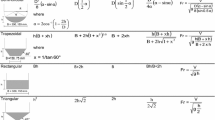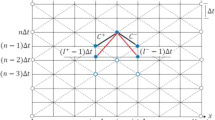Abstract
Extensive experimental results conducted in a 10-m flume for various types of non-Newtonian fluids spanning a range of cross-sectional open channel shapes are presented and analysed in depth in this work. Open channel flow of non-Newtonian slurries is relevant in mining and chemical engineering applications. This database coupled with the literature data is used to develop the generalised friction factor–Reynolds number correlations in a unified fashion. Much confusion still exists in the literature regarding the definition of non-Newtonian Reynolds numbers. This difficulty is circumvented by considering two widely accepted definitions of the Reynolds number, namely due to Haldenwang et al. (Hydrotransport 15: 15th international conference on the hydraulic transport of solids in pipes, Banff, pp 755–768, 2002) for open channel flow and the modified Metzner–Reed pipe flow Reynolds number adapted for open channel flow. Three different types of purely viscous non-Newtonian fluids in rectangular, trapezoidal, triangular and semi-circular channel shapes were tested. The modelling procedure of Garcia et al. (Int J Multiph Flow 29:1605–1624, 2003) used for pipe flow predictions was extended to the present work. The logistic dose curves based on the Reynolds number proposed by Haldenwang et al. [14] performed better than those based on the adapted Metzner–Reed Reynolds number. Correlations developed can be used for the design of open channels of various shapes to transport non-Newtonian fluids.



















Similar content being viewed by others
Abbreviations
- a :
-
Channel shape factor constant for laminar flow, Eq. (12) (–)
- A :
-
Cross-sectional area of flow (m2)
- b :
-
Power law exponent taken as −1, Eq. (12) (–)
- c :
-
“Blasius” power law constant for turbulent flow, Eq. (13) (–)
- d :
-
“Blasius” power law exponent for turbulent flow, Eq. (13) (–)
- D :
-
Pipe diameter (m)
- e :
-
Composite power law friction factor exponent, Eq. (11) (–)
- j :
-
Composite power law friction factor exponent, Eq. (11) (–)
- f :
-
Fanning friction factor (–)
- F 1 :
-
Laminar flow power law friction factor (–)
- F 2 :
-
Turbulent flow power law friction factor (–)
- f mB :
-
Modified Blasius friction factor, Eq. (4) (–)
- f pred :
-
Predicted Fanning friction factor based on Eq. (14) (–)
- f exp :
-
Experimental Fanning friction factor Eq. (14) (–)
- f exp(ave) :
-
Averaged experimental Fanning friction factor Eq. (14) (–)
- g :
-
Acceleration due to gravity (m/s2)
- K :
-
Laminar flow constant in the f vs. Re relationship (–)
- k :
-
Consistency coefficient (Pa sn)
- k′:
-
Apparent consistency coefficient, Eq. (7) (Pa s)
- n :
-
Flow behaviour index (–)
- N :
-
Number of points, Eq. (15) (–)
- n′:
-
Apparent power law index, Eq. (6) (–)
- P :
-
Wetted perimeter (m)
- Q :
-
Volumetric flow rate (m3/s)
- R 2 :
-
Correlation coefficient (–)
- Re :
-
Reynolds number (–)
- Re H :
-
Haldenwang et al. Reynolds number, Eq. (3) (–)
- Re MR :
-
Metzner–Reed Reynolds number adapted, for channel flow Eq. (5) (–)
- R h :
-
Hydraulic radius (m)
- t :
-
Composite power law friction factor exponent, Eq. (11) (–)
- V :
-
Average velocity (m/s)
- η B :
-
Bingham plastic viscosity (Pa s)
- Θ :
-
Channel angle from the horizontal (°)
- ξ :
-
Ratio of wall shear stress to Bingham yield stress (–)
- ρ :
-
Density (kg/m3)
- τ 0 :
- τ w :
-
Average wall shear stress (Pa)
- τ y :
-
Yield stress (Pa)
References
Alderman NJ, Haldenwang R (2007) A review of Newtonian and non-Newtonian flow in rectangular open channels. Hydro transport 17, The Southern African Institute of Mining and Metallurgy and the BHR Group, Cape Town, South Africa, pp 87–106
Burger J, Haldenwang R, Alderman NJ (2010) Friction factor-Reynolds number relationship for laminar flow of non-Newtonian fluids in open channels of different cross-sectional shapes. Chem Eng Sci 65(11):3549–3556
Burger J, Haldenwang R, Alderman NJ (2010) Experimental procedure and database for non-Newtonian flow in different channel shapes. J Hydraul Res 48(3):363–370
Burger J, Haldenwang R, Alderman NJ (2014) Laminar and turbulent flow of non-Newtonian fluids in open channels for different cross-sectional shapes. ASCE J Hydraul Eng
Chanson H (1999) The hydraulics of open channel flow. Arnold, London, pp 69–74
Chhabra RP, Richardson JF (2008) Non-Newtonian flow and applied rheology, 2nd edn. Butterworth-Heinemann, Oxford, pp 181–182
Chow VT (1959) Open channel hydraulics. McGraw-Hill, New York, pp 9–12
Clarke MT (1993) Rheological additives. In: Laba D(ed) Rheological properties of cosmetics and toiletries, Chap 4. Marcel Dekker Inc, New York
Coussot P (1994) Steady laminar flow of concentrated mud suspensions in open channels. J Hydraul Res 4(32):535–558
Fitton TG (2007) Tailings beach slope prediction. PhD thesis, RMIT University, Melbourne, Australia
Fitton TG (2008) Non-Newtonian open channel flow—a simple method of estimation of laminar/turbulent transition and flow resistance. In: Fourie AB, Jewell RJ, Paterson A, Slatter P (eds) Paste 2008, Kasane, pp 245–251
Fuentes R (2004) Slurry flumes in Chile (Keynote Address). Hydrotransport 16: 16th international conference on the hydraulic transport of solids in pipes, Santiago, Chile
Garcia F, Garcia JC, Padrino JC, Mata C, Trallero JL, Joseph DD (2003) Power law and composite power law friction factor correlations for laminar and turbulent gas–liquid flow in horizontal pipelines. Int J Multiph Flow 29:1605–1624
Haldenwang R, Slatter PT, Chhabra RP (2002) Laminar and transitional flow in open channels for non-Newtonian fluids. Hydrotransport 15: 15th international conference on the hydraulic transport of solids in pipes, Banff, pp 755–768
Haldenwang R (2003) Flow of non-Newtonian fluids in open channels. Unpublished D. Tech thesis, Cape Technikon, Cape Town, South Africa
Haldenwang R, Slatter PT (2006) Experimental procedure and database for non-Newtonian open channel flow. J Hydraul Res 44(2):283–287
Kazadi DM (2005) Non-Newtonian losses through diaphragm valves. MTech thesis. CPUT Theses and Dissertations. Paper 190. http://dk.cput.ac.za/td_cput/190
Kozicki W, Tiu C (1967) Non-Newtonian flow through open channels. Can J Chem Eng 45:127–134
Kozicki W, Tiu C (1986) Parametric modelling of flow geometries in non-Newtonian flows. Encycl Fluid Mech 7:199–252
Lazarus JH, Nielson ID (1978) A generalised correlation for friction head losses of settling mixtures in horizontal smooth pipelines. Hydrotransport 5, 5th international conference on the hydraulic transport of solids in pipes, Paper B1
Minussi RB, Maciel G (2012) Numerical experimental comparison of dam break flows with non-newtonian fluids. J Braz Soc Mech Sci Eng XXXIV(2):167–178
Naik B (1983) Mechanics of mudflow treated as the flow of a Bingham fluid. Unpublished PhD thesis, Washington State University, Pullman, WA
Patankar NA, Joseph DD, Wang J, Barree RD, Conway M, Asadi M (2002) Power law correlations for sediment transport in pressure driven channel flows. Int J Multiph Flow 28:1269–1292
Slatter PT (1994) Transitional and turbulent flow of non-Newtonian fluids in pipes. Unpublished PhD Thesis, University of Cape Town, Cape Town
Straub LG, Silberman E, Nelson HC (1958) Open channel flow at small Reynolds numbers. Trans ASCE 123:685–706
Acknowledgments
The authors would like to acknowledge the National Research Foundation of South Africa and the Cape Peninsula University of Technology for funding this research.
Author information
Authors and Affiliations
Corresponding author
Additional information
Technical Editor: Monica Feijo Naccache.
Rights and permissions
About this article
Cite this article
Burger, J.H., Haldenwang, R., Chhabra, R.P. et al. Power law and composite power law friction factor correlations for laminar and turbulent non-Newtonian open channel flow. J Braz. Soc. Mech. Sci. Eng. 37, 601–612 (2015). https://doi.org/10.1007/s40430-014-0188-1
Received:
Accepted:
Published:
Issue Date:
DOI: https://doi.org/10.1007/s40430-014-0188-1




